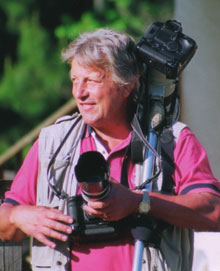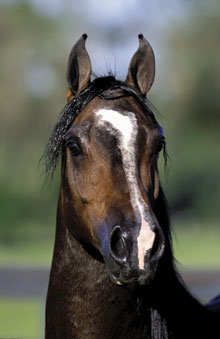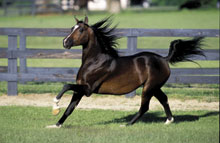



Rich gold and warm as velvet, late afternoon sunlight burnishes the coats of five Paint horses milling in a grassy paddock in northwest Marion County. Abruptly they turn, attention captured by the approach of a tall man in shorts, wearing a photographer’s vest and carrying a large camera.
Another camera hangs from a strap around his neck. He wears neither hat nor sunglasses, and the fine lines around his eyes hint that this is his custom.
The man pauses, looks away from the small herd to encourage movement and as one, they break into a canter, moving in a swirl of black, brown, sorrel and white, manes edged in gilded sunlight. He is ready for them, camera focused and whirring off half a dozen shots in seconds.
Curious, they circle back to investigate and this time the photographer entices them closer, making soft chirps and noises that cause each horse to slow and direct its attention to this human who has entered their space. The soft, late light is perfect, the horses’ expressions alert and inquisitive. In the span of 20 minutes or less, several rolls of film are shot and the session is over.
The horses’ owners know these pictures may soon grace a calendar, magazine or book. Capturing those images is all in a day’s work for international equestrian photographer Bob Langrish.
—
The renowned English-born photographer has spent the past 30 years perfecting his craft and is at the top of his game today. Ocala is one of the many locations on which he relies for beautiful horses in attractive settings. Through the years, Langrish has traveled the world, photographing virtually anything and everything to do with horses. He has built an impressive library of 300,000 slides, ranging from, as he puts it, “AI to zebras.”
Langrish’s photographs have completely illustrated some 100 books, with an average of five new books released annually. This year alone his photos will illustrate a veterinary book on horse care, a book of American horse breeds, a children’s how-to-ride book, and another on the sport of reining.
Gone are the days of peddling photos to publishers; now the book publishers come to Langrish. As do calendar and magazine publishers. If there’s a calendar hanging on your wall featuring beautiful horses in scenic surroundings, odds are Langrish shot the images. His photographs regularly appear in magazines in 14 different countries. In the United States he is on retainer for Fancy Publications, publisher of Horse Illustrated, and he has similar arrangements with magazines in Italy and France. A number of companies use his photographs in their advertising, including horse health giant Farnam Companies, State Line Tack, Dover Saddlery, and others.
Langrish started building the slide library about 15 years ago. Prior to that he photographed equestrian events and sold photos to the riders. His subjects ran the gamut in those years; the day after he returned from shooting the Seoul Olympics he was back in England photographing a junior Pony Club event. After publishers began routinely requesting his work and his collection of images expanded, Langrish found the slide library could generate a pleasant income. Today he is in the enviable position of taking only the jobs he wants.
Rather than work on commission, he prefers to cover his own expenses in order to keep the copyright on his images. His name is undoubtedly high on the list of United’s top customers, since he logs approximately 100,000 miles per year with that airline.
“My job has me chasing the sun around the world,” laughs Langrish, whose tan and smile lines give testimony to his travels. On the road about one-fourth of the year, he schedules most of his photography in the U.K. from June to September. “Theoretically, the weather is supposed to be good in England at that time, but being England, that doesn’t always work. That’s why I spend so much time working abroad.”
Langrish comes to the States seven or eight times a year and two of those trips bring him to the Sunshine State — first to south Florida where he shoots some of the world’s top riders competing at Wellington, then north to Ocala with its hundreds of horse farms.
Ten years ago someone recommended Ocala as a great spot for photographing horses, so Langrish booked a trip to investigate the area himself. Idyllic surroundings, friendly people and the wide diversity of breeds won him over and Langrish has returned every spring for the past decade.
Other stops on Langrish’s visits to the States include Lexington, Texas, California, Maryland, Virginia, Colorado, Arizona, Nevada and Vermont.
—
Horses “au natural” are his favorite subjects, whether running in a herd or individually, grazing, playing and relaxing in a group, or close up for a headshot. He prefers them without halters or other signs of “civilization” and relishes catching them in their best light (no pun intended). It’s all about showcasing the horse’s natural elegance and movement in a picturesque setting.
Although Langrish has found virtually any breed can result in a stunning picture, among his favorite breeds to photograph are Arabians (“they are so expressive and animated”); Andalusians (“they are basically large Arabs and very powerful”); and Fresians (“they are powerful and majestic”).
“Horses are magical animals,” says Langrish, adding that the best part of his job is capturing their power and sophistication on film. He looks for power in those moments when the horse is collected, such as in a controlled canter. He finds finesse and sophistication in those shots when the horse is graceful and fluid, as in an extended trot.
When Langrish enters the paddock or field, his equine subjects are immediately aware, not only of his presence, but of the fact that he understands them. Although he has never been a rider, years spent in the company of horses have made Langrish wise in the ways of horse psychology, and he relies on this knowledge throughout a shoot.
Carrying his large camera, which alone weighs 22 pounds, and another camera around his neck, Langrish walks towards and away from the horses. If he wants a horse to look at him, he makes eye contact; if he wants them to run or move off, he looks away and ignores them. He alternately makes soft chirping noises, or a more intimidating predator-like “bear” noise to get an alert expression with the horse’s ears up and head high.
“I don’t waste film,” notes Langrish. “It’s pointless pressing that button unless you have something worth taking. After years of experience you know when to keep your finger poised waiting for that split second when the horse turns and the light is right.”
Because conditions are so important when it comes to the final product, Langrish shoots only in the early morning, from about 8 to 10am, and in the late afternoon, early evening. Since he does not edit or correct photos on a computer, he always considers the background, making sure there is nothing to detract from the horse.
Recognized as one of the foremost equestrian photographers in the world, Langrish never formally studied photography. Completely self-taught, he learned the way he advises others to learn: through trial, error and practice.
—
Born in England, Langrish, 53, resides in Cheltenham, a town in the heart of the Cotswolds where the National Hunt Festival is held every spring. He and wife, Linda, live in a stately Regency house that is more than 200 years old.
Although intrigued by photography in his early teens when he got his first camera, Langrish didn’t immediately consider it as a career. His father was a captain in the police force and Langrish followed in his footsteps, joining the police cadets at age 16 and becoming a London police officer — that’s a “Bobby” to us Americans. In his early 20s, he decided to pursue his interest in photography and started out in auto racing, then moved on to four-footed horsepower. He was 23 when he first captured horses on film.
Langrish started out using Nikon, but switched to Canon when that company headhunted him in 1992, urging him to use their equipment. Today he uses a Canon EOS 1V mounted on a monopod, with a 400mm F2.8 lens. Around his neck he carries another Canon EOS 1V, this one with a 70-200mm F2.8 lens, to which he can add a 1.4 converter capable of increasing the lens to 100-280mm.
Although he admits one day publishing will go the way of digital, calendar and book publishers still want transparencies, so Langrish is happy to accommodate them and shoot slide film.
“I’m considered one of the ‘old farts’ among all the young photographers in the FEI (Federation
Equestre Internationale) world because I’m still using film instead of digital, but at the end of the day I’m not at the computer sharpening, cropping and so forth. If I take a bad picture — and I do — it goes in the rubbish bin.”
Langrish relies on Provia 100 ISO professional slide film by Fuji for bright days, and turns to Kodak
Ektachrome 100 SW slide film on flat or “dull” days when the sun doesn’t shine.
If he isn’t traveling, Langrish can either be found on a local photo shoot or at his office in England.
He has his slides processed locally, then edits them down to images he likes. The two women, both riders, who work in his office caption each slide with the horse’s name, breed, and farm name. Langrish then sorts through these images, selecting ones to be put on CDs and sent to magazines in over a dozen countries, as well as book publishers in the U.K. and U.S.
A typical day also includes handling inquiries for photos needed for advertising, Internet sites, and answering e-mail. “I get a lot of children sending e-mails from around the world that want to use my pictures on their virtual websites,” says Langrish. “My thought is, if there’s no commercial gain, let them use the pictures. We were all kids once, and who knows, those kids might turn out to be editors or publishers one day.”
—
When not behind a camera, Langrish enjoys organizing dinner parties and cooking, and has a passion for fine wines from around the world. A few years ago he took up golf and tries to play twice a week, or more, if the climate allows. (In England, it’s sometimes called “ice golf,” he admits.)
Equine photography has taken Langrish to unusual locations, resulting in some remarkable experiences. One of the most memorable occurred 10 years ago when he was photographing various horses for a breeds book.
“I was held up at machine gun point by soldiers in Turkey,” Langrish relates. “I was going to the Army Veterinary Corps to take photos when I saw some native work horses in the village. I stopped to take pictures of them and when the soldiers saw my cameras with the big, long lenses on the seat beside me, they weren’t impressed.”
What Langrish didn’t realize at the time was that the village was near a submarine base. Soldiers held him for 20 minutes — roughly an eternity when viewed from the business end of a machine gun — before the misunderstanding was cleared up.
“After that they patted me on the back and asked if they could help show me the way,” he recalls wryly.
The Ultimate Horse Book literally took Langrish around the world, from locations near his own back yard to remote sites that required a guide to translate, such as the Caucus Mountains in Russia, where he photographed herdsmen with their mountain horses. Published 10 years ago, this particular book made Langrish a highly respected name when it came to breed photography and enabled him to add even more breeds to his slide library. Today, he has on file some 170 different breeds of horses and ponies from all over the world.
Some may think it ironic that, while Langrish makes a very good living photographing horses, he has never been a rider. But don’t expect that to change.
“I have an affinity with horses to show them at their best and I understand them on the ground, but I will not get on a horse,” he says emphatically. “They bite at one end, kick at the other, and they’re uncomfortable in the middle. I’ve seen two riders killed and lots of horrendous accidents. There’s no chance of me riding, no matter how bomb proof the horse!”
Next year Langrish will shoot his fifth Olympics, but he’s still eager to discover new locations and horses that are nice examples of their breed. To justify a trip, he tries to find about 12 farms in one area to make it worth his travel time.
Although Langrish has spent the past three decades perfecting his craft, there are still moments when he catches a horse at just the right instant, at just the right angle, so that the resulting image impresses even him.
“I’ve taken so many and it isn’t often that a photo will jump out and say ‘Wow!’ but it happens occasionally,” he says with a chuckle.
For the rest of us, Langrish’s photos continue to be a source of pleasure. In capturing the equine essence on film, he allows countless viewers to appreciate what he saw in those perfect moments on location half a world away.
(Cynthia McFarland is a fulltime freelance writer and photographer who writes regularly for a number of national horse publications. The author of two non-fiction children’s books, in her spare time she enjoys trail riding with her Appendix QH gelding, Sierra [a.k.a. “Mr. Brown”]. She can be reached at cynthia@ocalastyle.com)
Bob Langrish In Print
BOOKS:
The Life of Horses
By Jane Holderness-Roddam
Hardcover, 256 pages
The Big Book of Horses: The Illustrated Guide to More Than 100 of the World’s Best Breeds
By Fran Ames & Lesley Bayley
Hardcover, 176 pages
CALENDARS:
Arabians Wall Calendar: 2004
14 pages
$11.99
Horses Mini Wall Calendar: 2004
12 pages
$11.99
Other information and merchandise can be found online at:
http://www.boblangrish.com






